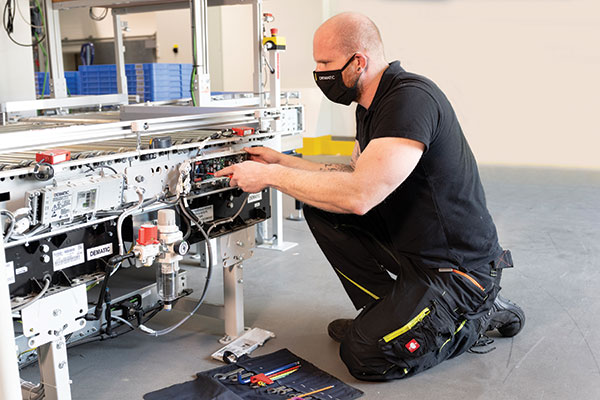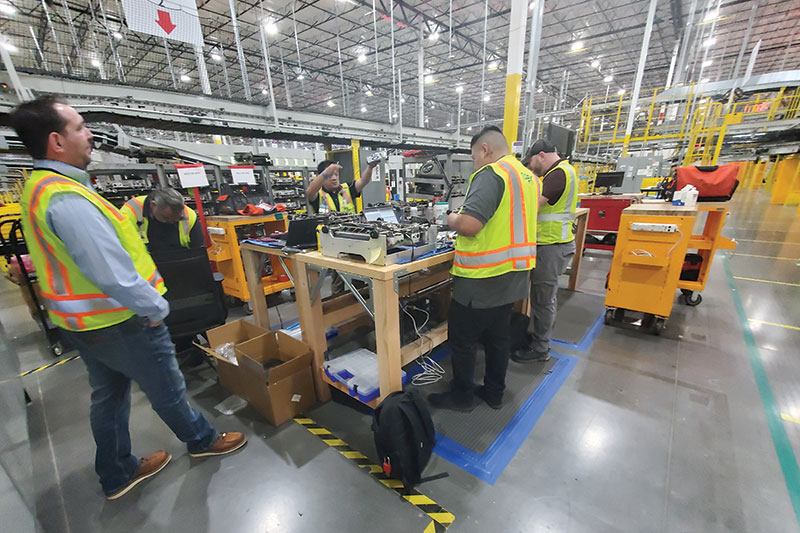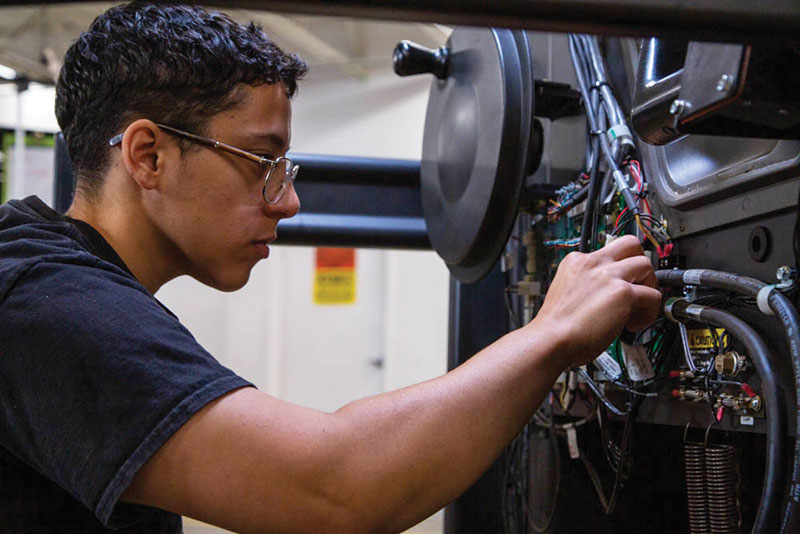What’s your strategy to find/hire/train/retain techs?
It’s a battle out there, but new approaches are making progress to bring the best maintenance techs into the industry.

Some time ago, there was a conference on the future of warehousing and distribution. For the first hour, the room’s walls literally reverberated from the attendees’ anguished gripes that materials handling didn’t get the C-Suite respect it deserved.
Finally, a vice president from a winemaker could remain quiet no longer. She asked everyone to stop complaining and start educating the C-Suite instead. Just like she had done quite successfully.
She was both forceful and persuasive. And it quickly became clear that she was the only person in the room with a strategy, not just a list of complaints.
We find ourselves in much the same spot today when it comes to finding/hiring/training/retaining maintenance technicians.
Yes, it’s a rough slog. However, finding and developing technicians is not a hopeless situation.
What’s needed instead is a new strategy. And from recent discussions across the industry, it seems that a pivot is underway as new talent development strategies develop.
In some cases, the C-Suite is beginning to have a new view. Some now think of techs who have careers at the company not just a job.
It’s part of a fundamental shift in how people understand the value of techs. Traditional phrases such as “head count” and “cost per tech” have been joined or even replaced with C-Suite favorites such as “business continuity” and “profitability.”
In other words, the value of techs is being discovered by people who traditionally thought of them as a cost center. Instead, the C-Suite is beginning to understand that techs are an essential service that keeps equipment running without unexpected interruption, product moving and customers satisfied. That’s also known as respect.
Techniques are also evolving for finding people in the first place. And as you probably already expect, both training and pay are getting another look, too.
None of this sidesteps the current challenges of finding labor. But there are ways to move ahead.
Tech hiring on the rise
You did read that right.
“Right now, we’re on pace to hire 100 new techs this year,” says Dave Beres, director of warehouse automation field service at OPEX. “If you talked to me six months or a year ago, I would have told you we were way behind in being able to hire like that,” he adds.
And no, Beres didn’t find a secret village of techs who want to work in materials handling automation. Instead, he relies on recruiters to find new candidates. But as he discovered, not all recruiters are up to the job. It required considerable effort and even a couple of failures before finding the right recruiting firm. Beres says his average time to find and hire a candidate has shrunk from 60 days to 35 days.

Over at Raymond, tech hiring is increasing, too. According to Dave Norton, vice president of customer solutions, the company has expanded its tech workforce by 5% in the first quarter alone.
What’s his secret? “We spend a ton of time on recruitment,” Norton says. He characterizes Raymond’s hiring efforts as more structured and organized to the point this is delivering a competitive advantage when hiring.
And that doesn’t include poaching techs from competitors. “We much prefer to train techs ourselves. We want to bring them along with our training program,” he adds.
Dematic is also making headway in the pursuit of new hires. “I can’t quantify how much more success we’re having right now with hiring, but it is easier to fill requisitions,” says Scot Filgis, director of resident maintenance.
Filgis likes to focus on candidates with an associate degree and community college training. “Combine that with attitude and aptitude, and we’ve got a solid candidate,” he adds. He also likes LinkedIn and referrals from employees.
Dematic has two teams of techs. Filgis oversees the customer service techs who support and maintain installed systems. There are also system installation techs who Timothy Walsh, senior director of installations, guides.
Walsh, too, is adding techs to keep pace with a full schedule of automated system installations. Walsh also stays close to community colleges to find new techs.
By the way, everyone we talked to will also say that an important aspect of their hiring process is pay scale. And as expected, higher pay is common; however, no one is willing to offer any specifics. But we can probably take their word for it.
On the end user side, Target is highly focused on adding hundreds of techs over the next three years. The retailer has a new talent development strategy, a healthy budget and C-Suite involvement to ensure that happens.
The baseline for all of that was set when the company rewrote its maintenance tech job descriptions that emphasize skill sets that correlate directly to multiple levels of technician responsibilities. Different levels of responsibilities build a career. And in many cases, that career starts with community colleges, which the retailer stays close to these days.
Focus on profile
The starting place for hiring people, of course, is their personality and aptitude profile. In addition, who gets hired also depends on the current and future makeup of technician teams.
For instance, Walsh and Filgis at Dematic both have a team of techs. But they are different. Walsh’s crew moves site to site around the country installing new DCs. Filgis’ techs are embedded at a single location as a full-time support team. Those are two quite different work arrangements that appeal to different people.
They also look for similar, but different aptitudes. Walsh’s techs are typically mechanics or electricians. But a strong need also exists for people proficient in controls, especially programmable logic controllers. That brings in a network aptitude, too.
“These people are part equipment and system installers as well as controls engineers,” says Walsh. “Good candidates here have a clear mind and a good work ethic,” he adds.
Filgis’ customer service techs are traditional preventive maintenance people with mechanical, electrical or controls aptitudes. “Every shift needs one controls person. Ideally, we develop people with the full range of mechanical/electrical/controls aptitudes,” he adds.
Filgis looks for people with an ability to identify what’s wrong with equipment and determine a path to restore it to full operation. “Getting there requires an eagerness to learn, to want to make things better and to communicate effectively with the facility’s operations people,” says Filgis.
That interface with the operations people is a primary focus for Beres at OPEX. When hiring, he looks for people who either have well developed soft skills or skills that can be developed with coaching. “We never used to teach soft skills, but we do now. Techs have to know how to talk with, look at and interact with the operations people,” says Beres.
Or as Norton says, “these techs are the face of Raymond and they need to conduct themselves that way.” He adds that a customer-facing personality is one of three key attributes he looks for in a candidate. The other two are maintenance skills aptitude and a learning attitude.
Path to proficiency
In talking to these experts, it became clear quickly that training is the segment where they spend the most time and effort in technician development. And well it should be. Not only are tech jobs changing in nature and required aptitudes, but companies have aspirations for longer term employment.
This takes two forms. One is how people are trained. The other is how they develop along a career path.
But even before the first training session, it has to be recognized that the tech workforce is getting younger. All experts agree here. That requires teaching with something other than a 300-page manual or sitting in a classroom being lectured at for too long.
Beres says it’s much more common to train people visually for a few minutes. Then have them work on equipment for hands-on experience for 20 or 30 minutes. “The whole idea is to help them retain next Monday what they ‘learned’ on Friday,” says Beres.

Those principles are also the basis for a new training certification program for automated equipment, explains Leo Reddy, CEO and founder of Manufacturing Skill Standards Council (MSSC). The supply chain automation technician certification requires 200 hours of classroom and hands-on experience for each of three certification levels. Reddy explains the first certification is for equipment maintenance, the second for system repair and the third is network repair.
Target is in the process of implementing the certification program, explains Steve Harrington, senior advisor for the Western United States at MSSC. He says the retailer has established two educational hubs that allow it to stream the training video to many locations around the country. While fewer than 100 people are currently enrolled, Target has an operating budget of several million dollars to develop the certification program for its national network of distribution centers, adds Harrington.
The three different levels of the MSSC certification program also underscore the new importance of adding new skills as techs develop in their career. More and more, companies are focused on creating formal programs for career development. And while this is in its earliest stages, at best, the move to careers could well provide the most appealing aspect of maintenance technician as an occupation.
So, the fight to find and keep maintenance techs continues. And it remains a fight. On a scale of 1 to 10 with 10 highest, the people interviewed gave themselves between a 6 and an 8 for each of the four stages of find/hire/train/retain. But that’s probably better than they would have said last year and probably not as high as next year.
As Beres says, his measure of success is to build tech teams with people who want to leave their job site better at the end of the day than it was that morning. Not a bad objective at all.

Article Topics
MRO News & Resources
Toyota Material Handling | 360 Support: Technicians Video Making the Case for Comprehensive Aftermarket Services Enterprise Device Solutions MRO, ML and AI are top of mind at Modex 2020Latest in Logistics
LM Podcast Series: Assessing the freight transportation and logistics markets with Tom Nightingale, AFS Logistics Investor expectations continue to influence supply chain decision-making The Next Big Steps in Supply Chain Digitalization Under-21 driver pilot program a bust with fleets as FMCSA seeks changes Diesel back over $4 a gallon; Mideast tensions, other worries cited Four U.S. railroads file challenges against FRA’s two-person crew mandate, says report XPO opens up three new services acquired through auction of Yellow’s properties and assets More LogisticsAbout the Author
Subscribe to Logistics Management Magazine

Find out what the world's most innovative companies are doing to improve productivity in their plants and distribution centers.
Start your FREE subscription today.
April 2023 Logistics Management

Latest Resources














